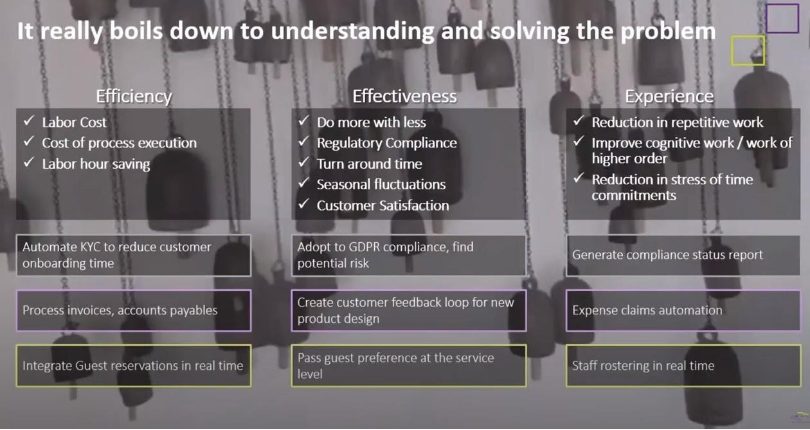Pathway to successful RPA Implementation
The interest in automation has reached new peaks. Organizations that had invested in automation are successfully riding the COVID-19 crisis. Others are hastily examining how their businesses could leverage automation. More specifically, they are examining Robotic Process Automation (RPA) to lower costs and overcome the depletion in workforce that has been a consequence of lockdowns and social distancing requirements. Organizations from Healthcare to Financial Services, Travel, Consumer Packaged Goods (CPG) and Manufacturing will have a higher quantum of automated processes by the time we emerge from the COVID-19 crisis.
While intent to implement RPA is growing, there are budget cuts to contend with. Organizations have therefore turned cautious, chiefly because they cannot identify the processes, they should automate to unlock the ROI, efficiencies and the bottom-line growth promised by RPA.
The path to successful RPA implementation is not always evident—and there is justified anxiety that the wrong decisions could produce sub-optimal returns. Processes in the functions like Finance, IT, HR and Procurement usually contribute to maximum number of use cases. Precedents could be one way to resolve the indecision.
Keep efficiency, effectiveness, and experience the focus
Organizations have a variety of stimuli that propels them towards RPA adoption: to drive efficiency, enforce compliance, create a fungible workforce, stay ahead of technology, increase the life of legacy investments, and improve employee morale. However, in the most immediate future, organizations considering RPA would do well to apply the technology to solve their most immediate business problems (see figure 1).
 Figure 1
Figure 1
ITC Infotech has worked with several customers across industries that illustrate the business problems that make ideal use cases for RPA:
- An airline customer wanted last minute emails received for cargo bookings to be turned into orders in their cargo system. They used RPA to solve the problem
- A US-based fashion house wanted to convert spread sheets coming in from designers into a Bill of Material and thereafter into purchase orders. RPA was the solution
- A banking customer wanted real time testing to be done for 300+ mainframe scenarios for new products. RPA-based testing enabled faster time to market
For organizations considering RPA, another way to resolve the problem would be to adopt RPA if it is a customer facing process. These processes always deliver value higher than others.
Get around the uncertainty
It is natural to be anxious about making investments in RPA. The technology is transformative but unfamiliar. Our experience shows that organizations are most concerned about selecting the right platform, they are unclear if their processes are ready for automation, if their business cases can withstand the test of time, and how quickly they will see ROI.
- Rule of Five: Our advice to organizations dipping their toes in RPA for the first time is relatively simple. Identify five processes that run across five application used by jobs that follow business rules and have little movement. We call it the Rule of Five. It provides a safe and quick test ground to understand what works for your organization and what doesn’t
- Process characteristics: The other approach to identifying the right use cases is to look at RPA to address tasks with a high volume, that are sensitive to speed, that are generally error prone and have irregular labor demands
- Part of digital transformation: Many organizations are gravitating towards the thought that RPA is not just a way to mitigate costs or improve operational efficiency but as a key component of their digital transformation agenda (added to the list of strategies that include data, analytics, social, and mobile)
Going wrong is not failure – it is learning
A CPG customer got ITC Infotech to help identify process that could be automated. After process mining and value modelling, we identified 10 processes ripe for RPA. The customer wanted six automated. However, we soon realized that not one of the six could be automated because the process templates were not standardized. The program had to be put on hold, the processes standardized, and the program re-started. But failure is not always a reason to bring an RPA program to a halt. It is often an indicator of a need for course correction.
Another CPG customer opted for a “fail fast approach” and started RPA implementation using a low scale product that did not touch their ERP. As adoption increased, SAP users in the organization also wanted to implement RPA. The customer realized the need for a product with larger capability and chose Automation Anywhere.
Anxiety around RPA vaporizes as adoption increases. Typically, organizations with less than 10 bots have challenges around process selection and business case creation. Organizations with 10 to 50 bots have challenges around governance, establishing operating models and modifying processes for automation. Organizations with over 50 bots cement an automation first cultural and nurture an RPA talent pool that ultimately sees the emergence of citizen developers.
Learning from experience
Our experience of working together provides insights that are worth sharing. When we decided to provide every one of our 9,000 employees with a bot – called Digital Buddy – we got Automation Anywhere as the expert services partner to assist in developing the bots and in managing change. We knew that our young and agile workforce wanted IT to help them move at speed. Our employees were eager to get their hands-on new technology and learn how to subsequently apply it to solve customer problems. Internally, we also realized there was more work than available skills. All the pieces necessary for RPA to find acceptance and deliver value fell in place.
Today, we have the expertise to deliver RPA projects to customers using an extensive bot library, through our automation-as-a-service offering and a catalogue of automatable processes based on experience.
Tomorrow’s economy will be led by digital workers that leverage RPA, with humans required for more cognitive work. Learning to tread the pathway to successful RPA implementation is therefore an urgent need today.
Author:
Sumeet Pathak,
Senior Director, Digital Innovation and Solutions,
Automation Anywhere
Mayank Jain
VP, Business Consulting Group,
ITC Infotech











